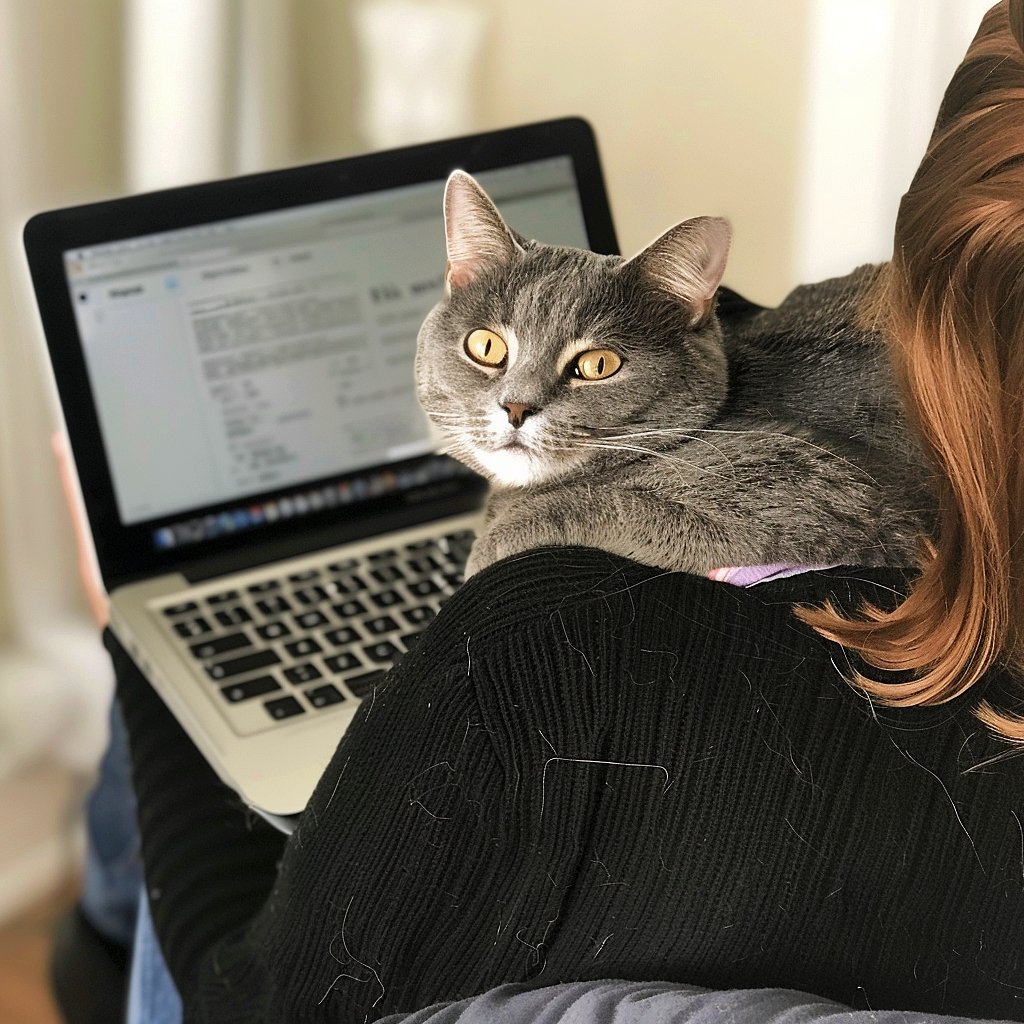Sucralfate is a medication that veterinarians often prescribe to cats with digestive issues, particularly ulcers and erosions.
It works by forming a protective barrier over these damaged areas, helping to promote healing and alleviate discomfort.
If your feline friend is showing signs of gastrointestinal distress, sucralfate may be a solution worth discussing with your veterinarian.
In this article, you’ll learn how sucralfate benefits cats, how to administer it effectively, and the potential side effects to be aware of.
Understanding how this medication works and its specific use in treating your cat will help you make informed decisions about their health care.
You’ll also find practical tips for monitoring your cat while they’re on this treatment.
Whether you’re looking for ways to prevent gastrointestinal problems or need guidance on dosages, this comprehensive guide aims to equip you with essential knowledge about sucralfate for your beloved pet.
Key Takeaways
- Sucralfate helps heal and protect your cat’s digestive tract.
- Proper administration and monitoring are crucial during treatment.
- Understanding potential side effects enhances safe usage.
Overview of Sucralfate
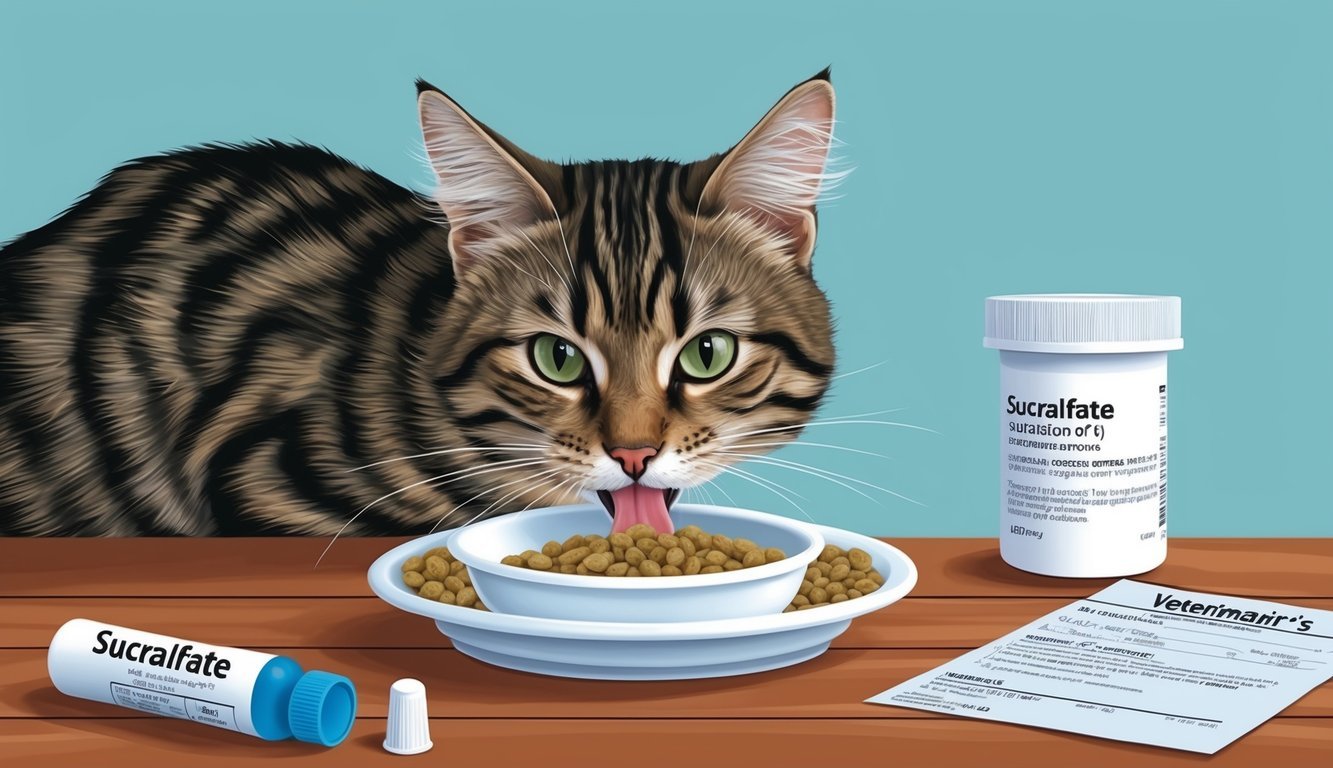
Sucralfate is an important medication for your cat, particularly in treating gastrointestinal issues.
It offers a protective solution for ulcers in the digestive tract by creating a barrier against harmful substances.
What Is Sucralfate?
Sucralfate, commonly sold under the brand name Carafate, is an oral medication designed primarily for ulcer treatment.
It is composed of sucrose octasulfate, which plays a vital role in its effectiveness.
This medication is used not only for cats but also for a variety of other animals.
It provides targeted relief by coating the mucosal lining of the esophagus, stomach, and small intestines.
When prescribed, it is essential to follow your veterinarian’s guidance on dosage and frequency to ensure the best outcomes for your pet’s health.
How Sucralfate Works
Sucralfate functions by forming a protective barrier over ulcers and erosions, effectively shielding them from harmful agents like hydrochloric acid and hydrogen ions.
This protective barrier minimizes irritation and promotes healing.
When ingested, sucralfate binds to proteins in the ulcer base, creating a paste-like substance.
This process enhances the local environment for healing, allowing the tissues to recover without further damage.
Additionally, sucralfate helps stimulate mucus and bicarbonate secretion, which further aids in protecting the stomach lining.
The overall mechanism contributes to reducing discomfort and supporting your cat’s recovery.
Benefits of Sucralfate for Cats
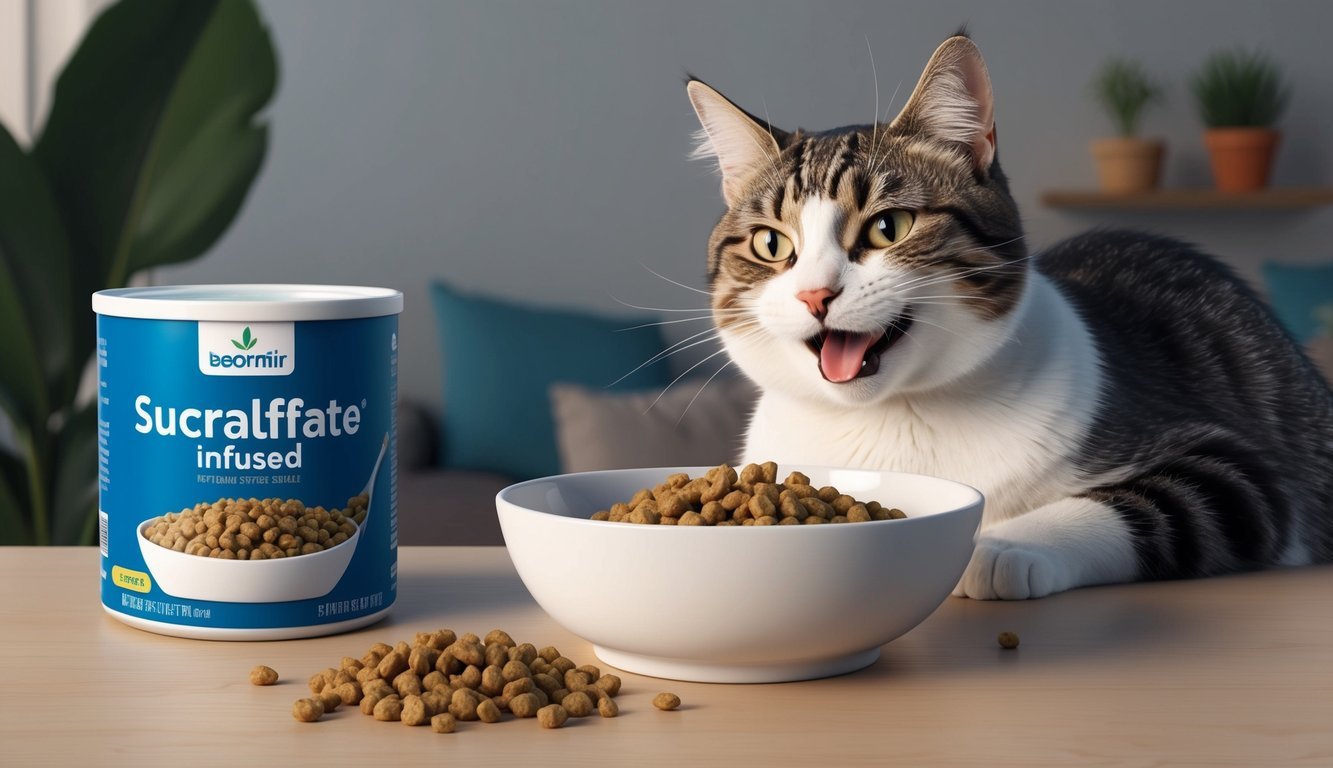
Sucralfate offers several important benefits for your cat’s digestive health.
It primarily acts as a protective agent for the gastrointestinal tract and is effective in treating ulcers.
Gastrointestinal Tract Protection
Sucralfate forms a protective barrier over the lining of the gastrointestinal tract, which includes the stomach and upper intestines.
This barrier helps shield the lining from harmful substances like pepsin and excess stomach acid, which can contribute to erosion and ulcer formation.
When your cat experiences vomiting or discomfort, sucralfate can minimize inflammation and irritation.
This medication is particularly useful during recovery from gastrointestinal issues.
In its presence, the protective barrier can promote healing and provide comfort, allowing your cat to regain its appetite and overall well-being.
Treatment of Ulcers
In cases of diagnosed ulcers, sucralfate serves as an effective treatment option.
It adheres to the ulcer site and forms a gel-like coating, which promotes healing by preventing further damage.
This is particularly crucial for both gastric ulcers and intestinal ulcers.
By protecting the ulcerated area, sucralfate helps reduce pain and discomfort associated with these conditions.
You might notice a decrease in symptoms such as vomiting or lethargy as your cat progresses through treatment.
The use of this medication can significantly improve your cat’s quality of life while it heals.
Administering Sucralfate to Cats
When giving your cat sucralfate, getting the dosage right and knowing how to prepare it can make all the difference.
Understanding these aspects will help ensure your cat receives the full benefits of the medication without unnecessary stress.
Correct Dosage
The correct dosage of sucralfate for cats typically ranges from 250 mg for small cats to a maximum of 1000 mg for larger breeds.
Your veterinarian will determine the exact amount based on your cat’s specific needs and weight.
Administration Schedule:
- Generally, sucralfate is given every 6 to 8 hours.
- It’s essential to administer it on an empty stomach, usually 2 hours before or after other medications.
Make sure to monitor your cat for any side effects during this process.
If you notice anything unusual, consult your vet right away.
Sucralfate Slurry
Cats often resist taking oral medications in solid form.
A sucralfate slurry can make administration easier.
To create the slurry, you can crush the tablet and mix it with a small amount of water or low-sodium broth.
Steps:
- Crush the Tablet: Use a pill crusher to break it down into a fine powder.
- Mix with Liquid: Combine the powder with enough liquid to create a thick consistency.
- Administer with a Syringe: Use an oral syringe to squirt the mixture into your cat’s mouth.
This method can improve acceptance and help ensure that your cat receives the full dose.
Always check with your vet to see if this method is suitable for your feline companion.
Possible Side Effects
When considering sucralfate for your cat, it’s important to be aware of potential side effects that may occur during treatment.
While most cats tolerate this medication well, some might experience mild to moderate reactions.
Here’s what you should know.
Common Side Effects
The most frequently reported side effects of sucralfate in cats include:
- Constipation: This is the most common reaction, as the medication can slow down intestinal movement. Monitor your cat’s litter box habits for any signs of straining or infrequent bowel movements.
- Vomiting: Some cats may experience nausea, leading to vomiting, particularly during the first few doses. If this happens, consider discussing the dosage with your veterinarian.
- Drooling: Increased salivation can occur in some cats. This may be a response to the medication’s taste or the way it coats the stomach lining.
These effects are generally mild and tend to resolve without intervention.
However, keeping an eye on your cat’s behavior is essential.
Rare Complications
While serious side effects are uncommon, they can occur.
Pay attention to these potential complications:
- Aluminum Toxicity: Since sucralfate contains aluminum, prolonged use may lead to accumulation in your cat’s body, potentially causing toxicity. Symptoms to watch for include lethargy, decreased appetite, and unusual behavior.
- Allergic Reactions: Though rare, some cats may develop hypersensitivity to sucralfate. Signs include itching, swelling, or difficulty breathing. If you notice any of these symptoms, seek immediate veterinary attention.
Always consult your veterinarian about your cat’s specific health needs and report any unusual symptoms.
Comparing Sucralfate With Other Treatments

When considering treatments for gastrointestinal issues in cats, it’s essential to compare sucralfate with other commonly used medications.
This section highlights how sucralfate interacts with proton pump inhibitors and antacids, as well as its combination potential with other medications.
Proton Pump Inhibitors and Antacids
Proton pump inhibitors (PPIs) like omeprazole and pantoprazole effectively reduce stomach acid production.
This action can help manage ulcers, but these medications do not provide a protective coating, unlike sucralfate.
Sucralfate acts locally in the gastrointestinal tract, forming a barrier over ulcerated areas.
While PPIs lower acid levels, they may not be as effective in coating existing ulcers.
Antacids, such as cimetidine and ranitidine, work to neutralize stomach acid.
While they offer immediate relief from heartburn and discomfort, they might not be as suited for long-term ulcer treatment when compared to sucralfate’s protective mechanism.
Combining With Other Medications
Using sucralfate in conjunction with other medications can enhance treatment effectiveness.
For instance, it can be combined with PPIs or antacids for comprehensive care.
When paired with a PPI like omeprazole, sucralfate helps coat ulcers while the PPI lowers stomach acidity.
You want to ensure there’s a time gap when administering these drugs, as antacids can affect the absorption of sucralfate.
It’s also crucial to consult your veterinarian before combining medications.
They can guide you on proper dosing schedules to avoid any interactions and maximize the treatment benefits for your cat.
Special Considerations for Sucralfate Therapy
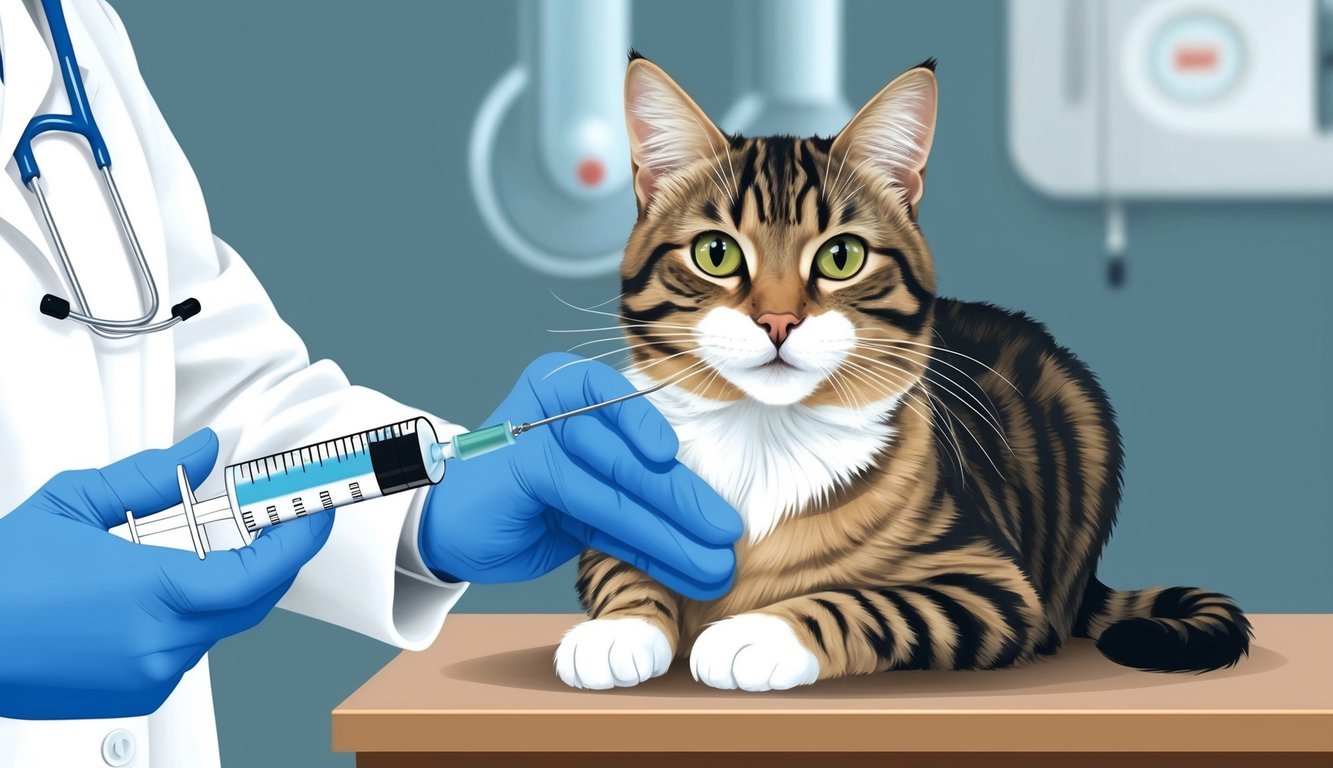
When considering sucralfate therapy for your cat, it’s essential to be aware of specific factors related to pre-existing conditions and potential drug interactions.
These considerations help ensure the safe and effective use of this medication.
Use in Animals With Pre-existing Conditions
If your cat has pre-existing conditions, consult your veterinarian before starting sucralfate. Renal failure can pose risks, as sucralfate’s excretion may be affected, leading to potential toxicity.
Cats with gastrointestinal issues might require careful monitoring to avoid complications.
Additionally, sucralfate might not be ideal for cats on NSAIDs due to the risk of gastric damage.
It’s also crucial to assess liver function, as impaired liver health can influence drug metabolism.
In such cases, your veterinarian may suggest monitoring liver enzymes or adjusting dosages accordingly.
Tailoring therapy for specific health challenges ensures that your cat receives the safest treatment.
Drug Interactions
Be cautious of drug interactions when using sucralfate.
This medication can bind to other drugs, potentially reducing their effectiveness.
For example, if your cat is taking certain antibiotics or medications that need to be absorbed, it’s best to separate doses by at least two hours.
Also, consider the presence of Prostaglandin E in any compounded medications your cat may use.
This could affect the gastrointestinal lining and influence how sucralfate works.
Always inform your veterinarian about your cat’s complete medication list to avoid adverse effects and ensure optimal treatment outcomes.
A comprehensive approach will promote the best health for your feline friend.
Dosage and Administration Guidelines
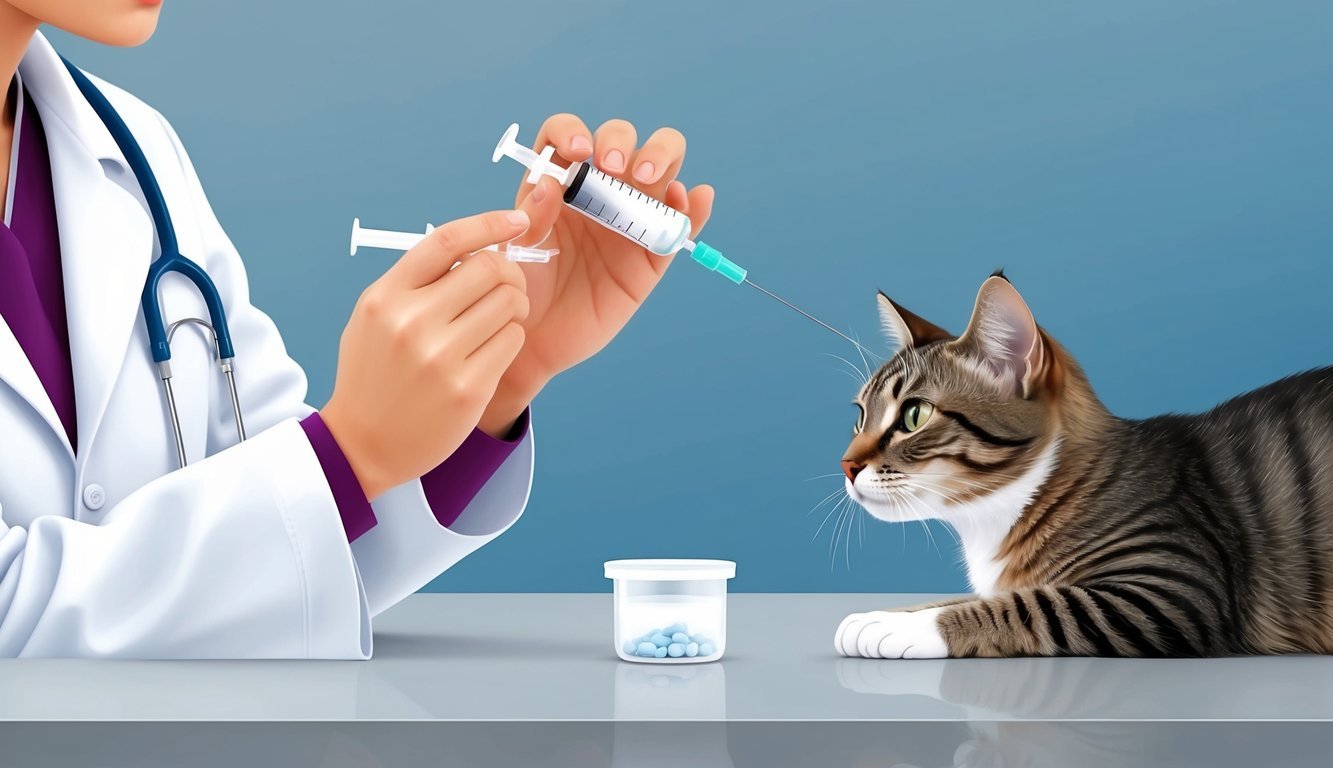
Getting the dosage right is crucial for your cat’s treatment with sucralfate.
Proper administration helps ensure efficacy while minimizing the risk of side effects or complications.
Here are the key details to keep in mind.
Determining the Correct Dosage
The usual dosage of sucralfate for cats ranges from 1/4 to 1/2 gram every six to eight hours.
Small dogs may receive similar amounts, while larger dogs often require up to 1 gram.
You should administer the medication on an empty stomach, ideally one hour before meals or two hours after.
Be sure to follow your veterinarian’s instructions closely.
If your cat has a specific condition, such as ulcers in the stomach or small intestine, your vet might adjust the dosage.
When in doubt, always consult with your vet for the most accurate information tailored to your pet’s needs.
What to Do About a Missed Dose
If you happen to miss a dose, take action as soon as you remember.
Administer the missed dose immediately.
However, if it’s almost time for the next scheduled dose, skip the missed one entirely.
Never double up on doses to make up for one you missed.
If you miss multiple doses or are unsure of what to do, contacting your veterinarian is important.
Keeping a consistent medication schedule is key to your cat’s recovery.
Consider setting reminders to help avoid missed doses in the future.
Beyond Cats: Sucralfate in Other Animals
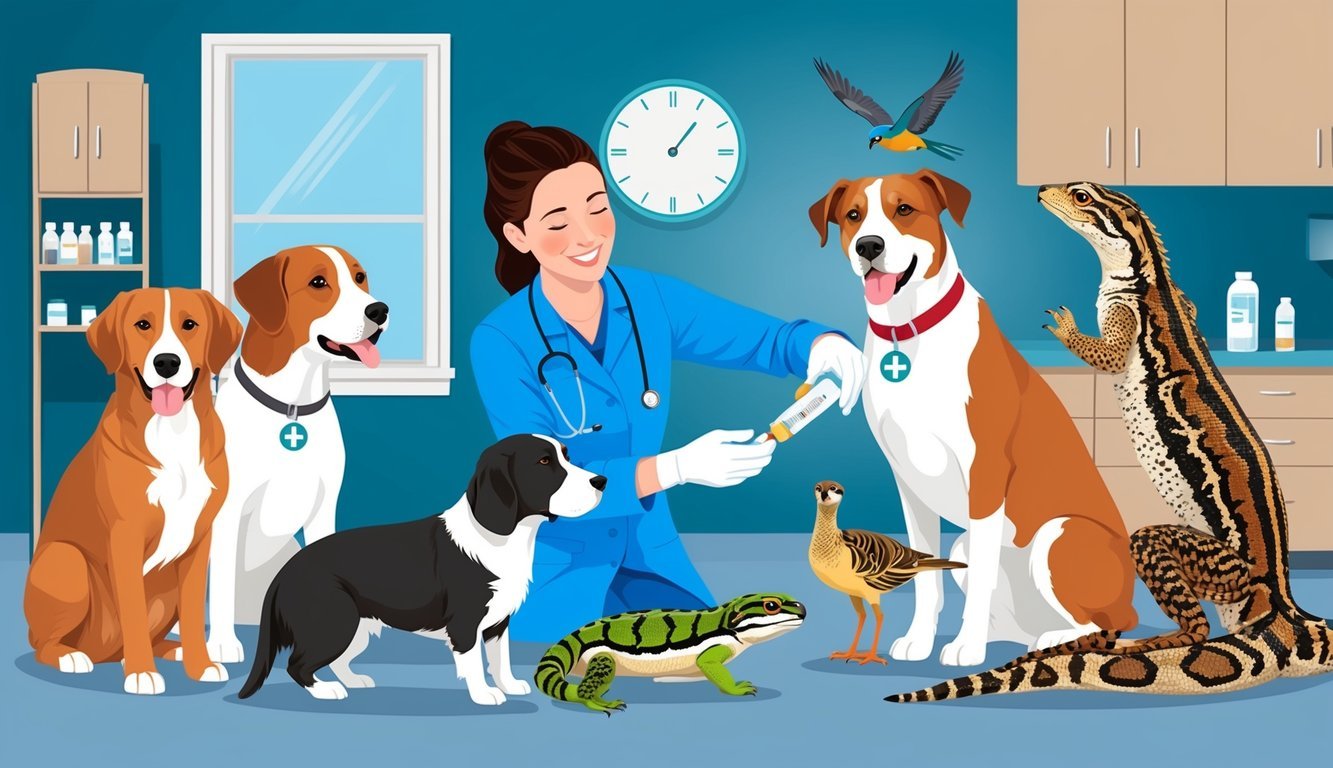
Sucralfate isn’t just for cats.
Its use extends to various other animals like dogs, horses, ferrets, and reptiles.
Here’s a closer look at how it functions in these species.
Use in Dogs and Horses
In dogs, sucralfate is often prescribed for gastrointestinal issues.
Doses can range from 250 mg to 1,000 mg, depending on the size of the dog.
Typically, it’s given every 6 to 8 hours as needed.
For horses, sucralfate plays a crucial role in treating conditions such as equine gastric ulcer syndrome.
It protects the stomach lining and can be administered as either a tablet or a slurry, similar to its use in dogs.
You must ensure it’s given separately from other medications.
This helps avoid interference with the absorption of other treatments.
Considerations for Ferrets and Reptiles
When it comes to ferrets, sucralfate is considered off-label but can be effective in managing digestive tract issues.
The usual approach is to administer it in a slurry form.
This method helps with digestion and absorption while being gentle on their system.
For reptiles, the use of sucralfate is less common.
However, it can be beneficial for those experiencing gastrointestinal discomfort.
Always provide it when the animal is well-hydrated.
Consult with your veterinarian to ensure proper dosing and administration timing.
This is critical for both ferrets and reptiles, as their digestive systems vary significantly from those of mammals.
Preventing Gastrointestinal Issues

